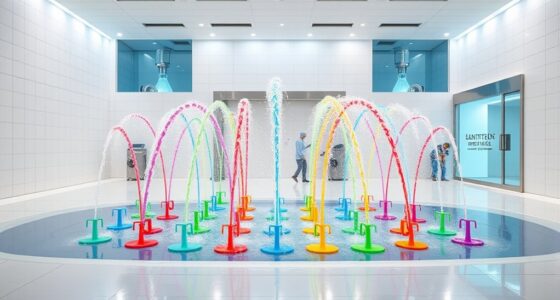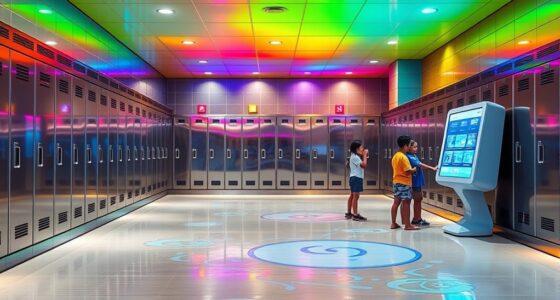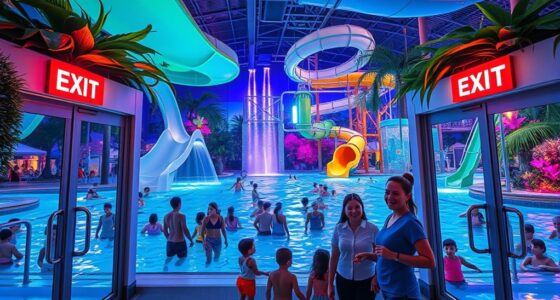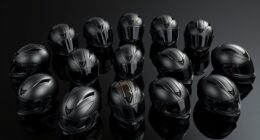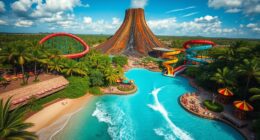Indoor water parks keep the air warm and dry using advanced HVAC systems that combine heating, ventilation, and humidity control. They utilize dehumidifiers and heat recovery units to remove excess moisture and recycle heat, ensuring a comfortable environment. Proper insulation, airtight structures, and strategic airflow help prevent condensation and drafts. If you want to discover how they balance humidity, temperature, and energy efficiency seamlessly, keep exploring these innovative climate control strategies.
Key Takeaways
- They use integrated HVAC and structural systems with insulation and airtight building envelopes to control temperature and humidity effectively.
- Dehumidification units, such as refrigeration-based or heat recovery systems, remove excess moisture from the indoor air.
- Humidity sensors and automated controls maintain relative humidity levels between 50-60%, preventing condensation and mold growth.
- Warm air distribution systems, including strategically placed ductwork and heat recovery devices, ensure even temperature and moisture control.
- Proper ventilation with strategically located intakes and exhausts removes humid, contaminated air, maintaining dry, comfortable indoor conditions.
Integrated HVAC Systems for Water Parks

Integrated HVAC systems are essential for maintaining a comfortable and safe environment in indoor water parks. They combine HVAC, structural, water loop, and energy recovery components to optimize performance. You need accurate load estimation that considers sensible and latent heat from swimmers, spectators, solar gain, lighting, and ventilation. Moisture load calculations must include pool surface evaporation, ventilation air moisture, and occupancy, not just dehumidification. Equipment sizing relies on local climate, pool size, use, and occupancy to ensure efficiency and comfort. Properly designed systems incorporate humidity & temperature control. Additionally, incorporating energy recovery systems can significantly reduce operational costs and improve sustainability. Compliance with safety, health, and energy standards is mandatory, requiring tailored systems for each facility. Proper integration guarantees balanced airflow, prevents condensation, and maintains air quality, creating a safe, comfortable space for guests while minimizing energy costs.
Dehumidification Techniques to Manage Moisture

Managing moisture effectively in indoor water parks depends heavily on dehumidification techniques that keep humidity levels comfortable and prevent structural issues. Dehumidification systems remove excess moisture using refrigeration-based or heat recovery units tailored to your pool’s size and environment. Energy-efficient models minimize power use while maintaining ideal humidity. Some systems reclaim condensate, reducing water waste by recycling it into the pool cycle. Combining dehumidification with ventilation enhances air quality and humidity control, ensuring warm, dry air reaches all areas. Proper air distribution prevents condensation and mold growth. Modern systems incorporate sensors for real-time monitoring and automatic adjustments, maintaining humidity between 50-60%. Incorporating energy recovery options further reduces costs, making moisture management both effective and sustainable. Additionally, understanding humidity control principles helps optimize system performance and maintain a comfortable indoor environment.
Heating Strategies for Comfortable Indoor Air

To keep indoor air warm and comfortable, you need effective warm air distribution and smart heating techniques. Heat recovery systems reuse waste heat to improve energy efficiency and maintain consistent temperatures. Using insulation and appropriate materials also helps retain heat and prevent drafts, ensuring a cozy environment for visitors. Implementing air circulation strategies can further enhance temperature uniformity throughout the space. Indoor pool heating design services can optimize these systems for maximum comfort and efficiency.
Warm Air Distribution
Achieving uniform and comfortable indoor air temperature in water parks relies on strategic air distribution techniques. You want to prevent cold spots and drafts while maintaining comfort. Warm air is evenly delivered through ductwork positioned around the pool room, ensuring consistent temperature. Air diffusers are placed near glass walls and spectator areas to prevent condensation and boost comfort. Supply air is introduced at higher elevations, promoting gentle mixing with cooler room air for thermal balance without turbulence. Recirculating warmed, dehumidified air helps stabilize temperature and reduces energy use. Variable speed fans allow precise airflow control, maintaining setpoints efficiently. Proper air mixing ensures the desired temperature is achieved throughout the space, avoiding temperature stratification and enhancing overall comfort.
Heat Recovery Techniques
Ever wondered how indoor water parks keep the air warm and comfortable while minimizing energy costs? Heat recovery techniques play a vital role. Glycol runaround loop heat exchangers transfer heat between air streams using glycol-filled pipes, preventing condensate freezing even in sub-zero temperatures. This system is durable and efficient, ideal for cold climates. Integrated heat pumps and dehumidifiers combine water heating, air conditioning, and humidity control, cutting costs by over 30%. Heat recovery ventilators (HRVs) and energy wheels transfer heat and moisture between outgoing and incoming air, reducing winter energy use by up to 85%. Indirect fired gas heaters with heat recovery coils preheat incoming air, lowering fuel consumption. Glycol loops utilize natatorium-grade coated coils for corrosion resistance. Additionally, heat recovery systems can be configured to optimize airflow and energy use, further enhancing indoor climate control. These systems maintain a stable, comfortable environment while saving energy and protecting against corrosion and condensation.
Insulation and Material Use
Insulation and material use are essential for maintaining a warm and comfortable indoor environment in water parks, especially in areas with high humidity and temperature fluctuations. Proper insulation mitigates heat loss and controls moisture, ensuring guest comfort and energy efficiency. Consider these key materials:
- Fiberglass Insulation: Cost-effective, water-resistant, ideal for general needs.
- Polyurethane Foam: Excellent thermal insulator, used in pipes and slide tubes.
- FOAMGLAS: High-performance roof insulation with low thermal conductivity and vapor tightness.
- Acoustic Insulation: Reduces noise and reverberation, enhancing the overall experience.
Choosing the right materials ensures the building stays warm, dry, and energy-efficient while supporting the park’s safety and comfort standards. Additionally, selecting materials with moisture control properties helps prevent mold growth and structural damage in humid environments.
Ventilation and Air Quality Control Measures

You need to make certain the ventilation system brings in enough fresh outdoor air to keep air quality high and dilute chloramines. Humidity-driven controls automatically adjust ventilation based on moisture levels, preventing excess humidity and mold growth. Additionally, incorporating chemical removal strategies like activated carbon filters helps eliminate airborne contaminants, maintaining a healthy environment for visitors and staff. Ensuring proper airflow management is essential for maintaining optimal indoor conditions and preventing issues related to poor air circulation. Customizable air dispersion systems, such as fabric ductwork designed specifically for pool environments, can further enhance airflow efficiency and ensure even distribution throughout the space.
Fresh Air Intake Systems
How do indoor water parks guarantee fresh, clean air despite high humidity and chemical fumes? They rely on carefully designed fresh air intake systems that balance visitor load and air quality. These systems continuously remove humid, chemical-laden air and replace it with dry, filtered outdoor air. To achieve this, they incorporate multiple strategically placed air intakes, such as near pools and spectator areas, ensuring proper ventilation rates. Modern units also combine intake airflow with dehumidification and heat recovery to optimize energy use. Key features include:
- Precise control of fresh air volume based on occupancy.
- Continuous removal of humid, contaminated air.
- Use of heat recovery to conserve energy.
- Strategic placement of air intakes for effective air exchange.
- They implement air quality control measures that monitor and adjust airflow to maintain optimal indoor conditions.
Humidity-Driven Ventilation Control
Humidity-driven ventilation control plays an essential role in maintaining air quality and comfort within indoor water parks. You rely on corrosion-resistant sensors that continuously monitor indoor relative humidity, typically kept between 50-60%. These sensors feed real-time data into automated feedback systems, which adjust HVAC operations to prevent over-humidification or excessive drying. Modulating hot gas reheat systems work alongside sensors to fine-tune humidity levels efficiently, conserving energy and minimizing evaporation. Proper humidity control is crucial for preventing condensation and reducing maintenance costs. Additionally, ventilation system automation helps optimize airflow based on occupancy patterns and environmental conditions, ensuring consistent indoor climate management. Pressure transducers help maintain negative air pressure in pool areas, preventing humid, chlorine-laden air from leaking into other spaces. Ventilation systems exhaust moist air while supplying conditioned outdoor air, with variable rates adjusting to occupancy and humidity levels. This integrated approach ensures a dry, comfortable environment while protecting building integrity and air quality.
Chemical Removal Strategies
Effective chemical removal in indoor water parks relies on carefully designed ventilation and air quality control measures that target airborne contaminants. You need to guarantee proper air exchange rates—typically 4–6 air changes per hour for natatoriums and 6–8 for spectator areas, per ASHRAE standards. To optimize ventilation:
- Use supply air calculations based on room volume and desired air changes to determine capacity.
- Strategically position supply and return vents, especially near the water surface, to move contaminated air toward exhausts.
- Incorporate exhaust fans and natural ventilation options when weather permits to dilute indoor pollutants.
- Install localized sensors for real-time monitoring of chemical levels, enabling dynamic adjustments to ventilation and filtration systems for effective chemical removal. Smart sensors can help optimize these processes by providing continuous data on air quality parameters. Additionally, understanding air exchange rates is crucial to maintaining a safe and comfortable environment.
Structural Features to Enhance Energy Efficiency

Structural features play a essential role in boosting the energy efficiency of indoor water parks by minimizing heat loss and controlling air quality. Proper sealing of the building envelope prevents cold outdoor air infiltration, which helps maintain consistent indoor temperatures. The use of ‘pucks’ on water slide openings reduces airflow through slides during non-operation, limiting heat loss. Large water features placed externally require airtight construction to prevent unwanted air exchanges. Well-sealed environments lessen the load on HVAC systems, conserving energy. Incorporating insulated structures like closed-air domes and high-performance glazing minimizes heat transfer through walls and roofs, sustaining warmer indoor air. These design choices lower heating demands and support year-round energy efficiency, ensuring you keep the space warm and dry while reducing operational costs. Effective ventilation systems also help remove excess humidity and improve air quality, further enhancing the indoor environment’s comfort and energy performance.
Sustainable Practices and Energy-Saving Technologies

Indoor water parks are increasingly adopting sustainable practices and energy-saving technologies to reduce operational costs and environmental impact. You can benefit from systems like heat recovery ventilation (HRV), which transfer heat between exhaust and fresh air, cutting winter heating needs by up to 85%. These systems use natural heat exchange via parallel air streams, requiring no extra electricity. Additionally, on-site combined heat and power (CHP) units generate energy efficiently, saving money and reducing carbon emissions—as seen at Great Wolf Lodge with a 10% carbon reduction and $1.3 million savings. Demand-controlled ventilation adjusts airflow based on occupancy, minimizing energy use. Solar thermal panels, geothermal systems, and smart automation further optimize energy consumption, while water recycling and efficient fixtures reduce both water and energy costs. Implementing energy-efficient building design strategies can further enhance these sustainability efforts and maximize cost savings.
Frequently Asked Questions
How Do HVAC Systems Adapt to Varying Occupancy Levels?
You’ll see HVAC systems adapt to changing occupancy levels by using variable airflow and dehumidification controls. As more people enter, the system increases ventilation and moisture removal via sensors and VFDs, matching demand in real-time. Energy recovery units and heat exchangers optimize thermal efficiency, while adjustable vents and fans guarantee even temperature and humidity. This dynamic adjustment keeps the air comfortable, dry, and energy-efficient regardless of occupancy fluctuations.
What Maintenance Is Required for Corrosion-Resistant Components?
You need to regularly inspect your corrosion-resistant components, focusing on weld joints, fasteners, and metal surfaces. Reapply protective coatings like epoxy primers and paints periodically, especially after exposure to splash or chlorinated water. Rinse stainless steel surfaces with fresh water after exposure, and promptly repair or replace any corroded parts. Keep water chemistry balanced and maintain ventilation to minimize chloramine buildup, helping these components stay durable and corrosion-free longer.
How Is Indoor Air Quality Monitored and Maintained?
You monitor and maintain indoor air quality by using advanced sensors to measure humidity and temperature continuously, adjusting systems automatically to keep conditions ideal. You rely on dehumidifiers and HVAC systems to remove excess moisture, circulate fresh air, and control chemical levels, ensuring a healthy environment. You also implement negative air pressure and energy recovery systems to contain pollutants, all while regularly servicing equipment to sustain efficiency and safety.
Can These Systems Be Customized for Different Water Park Sizes?
Yes, these systems can be customized for different water park sizes. You can select appropriate heating options like gas, electric, or heat pumps based on your park’s scale. Ventilation and dehumidification units are adjustable to match your facility’s surface area and occupancy. Smart controls and sensors help you fine-tune climate settings, ensuring efficient operation whether your park is small or large. Tailoring these systems optimizes comfort and energy use for your specific needs.
What Safety Measures Are Integrated Into HVAC Operation?
You need to guarantee your HVAC system includes safety measures like outdoor air filtration, dedicated exhaust fans, and negative room pressure to prevent contaminant buildup. Regularly monitor humidity, CO levels, and system failures with integrated controls. Ventilate continuously to reduce chloramines and microbial growth, and use materials resistant to corrosion. Emergency shutdown protocols and proper exhaust placement protect occupants from hazardous gases, ensuring a safe environment in your indoor water park.
Conclusion
By understanding how indoor water parks stay warm and dry, you see the intricate dance of technology and design working in harmony. These systems are the unseen guardians of comfort, turning humid, chilly air into a welcoming oasis. It’s as if they whisper a promise of perfect temperatures and pristine air, making every visit a breeze. When you step inside, remember: behind the scenes, advanced strategies keep the magic alive—your ultimate indoor escape.



